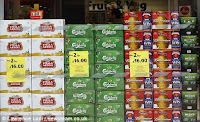Last Friday night, the local CAMRA branch did one of its regular monthly “Staggers” or pub crawls around the Shaw Heath and Higher Hillgate areas of Stockport. There were ten of us in the party, and I noticed, not for the first time, that, at 57, I was the youngest member of the party.
This underlines the demographic challenge facing CAMRA, which I referred to in
my post about the Revitalisation meeting. The active members of the organisation overwhelmingly come from the Baby Boomer generation, people born between about 1945 and 1965 and, as they fade from the scene, they are not being replaced. Clearly, with record membership numbers, CAMRA isn’t going to disappear any day soon but, without so many local activists on the ground, it will inevitably have to become a lot more centralised. To be fair, this is a problem faced by all kinds of other membership organisations, not just CAMRA, but few have such a bottom-up, democratic structure.
Whether or not CAMRA needs to review its basic principles to widen its appeal has been discussed at length elsewhere. But it has to be questioned whether, in an age of social media and hashtag campaigning, volunteering and “committee work” hold all that much appeal for the younger generation. At one time, this was often seen as a means of making social contacts, especially if you have moved to a new area, but, if you have Instagram and Snapchat, do people see that need any more?
It’s also the case, as David Martin points out, that younger people are increasingly turning their back on drinking alcohol, and going to pubs and bars, full stop. It’s not just that the particular variety championed by CAMRA no longer appeals. If that’s the case, they’re lost to you, and there’s nothing you can do about it.
Obviously it may be offputting for younger people if they turn up at a CAMRA event and find the average age is thirty or forty years higher than their own. But that’s the raw material you’ve got to work with, and attempts by august institutions to “get down wiv da kids” often just come across as laughable. It’s also a narrow and patronising view to assume that all young people want to sit on chromium stools in trendy bars drinking expensive craft keg.
Some types of events will appeal more to young people than others, but it may be that they’re not that interested in formal, organised events anyway. And it’s important to maintain a mixed economy of different types of activity to have an across the board appeal. Personally I can’t see the attraction of standing in a draughty industrial unit looking at stainless steel brewing vessels, but others do.
The whole concept of Staggers has also been called into question, with some dismissing them as a “route march” or “a soulless trudge”. Basically these are a set of organised pub crawls which, taken over a period of about a two and a half years, cover the vast majority of real ale pubs within the branch area, except for a handful that are out on a limb and can’t be fitted in to a feasible route. As Tandleman said here, back in the day “walking around a handful of pubs” was a common pursuit, especially on weekend evenings, but it seems to be much less favoured now.
In the past, the Staggers could be hard work but, as the number of pubs has reduced, and those that couldn’t keep real ale well have generally either abandoned it for keg or closed, they have become more manageable, and the average quality of both pubs and beer much higher. Of the five pubs visited last Friday, four – the Blossoms, Fairway, Sun & Castle and Red Bull – have been recentish Pubs of the Month, and the fifth, the Plough, while more of a plain, down-to-earth boozer, still managed to provide a perfectly decent pint of real ale. Very few require more than a mile’s walking through the course of the evening, which shouldn’t be too strenuous for delicate youngsters given that arthritic sixtysomethings can manage it.
I’ve always been fascinated by visiting different pubs, taking in their varying atmosphere and character, and seeing what’s new. Every pub is unique and has its own story to tell. Therefore, to me, the Staggers are probably the most eagerly anticipated events in the CAMRA social calendar, on a par with the annual Good Beer Guide selection bunfight. Certainly far more attention-grabbing than yet another “Meet the Brewer” talk from an identikit bearded clone droning on about New World hops. And it seems that one of my regular correspondents agrees with me:
If you’re interested in real ale, then the Staggers cover all the places that sell it. There isn’t some parallel universe of cool bars that they studiously avoid. So, if you dismiss them as old hat and something only suited to fuddy-duddies, then you’re dismissing real ale itself in the same way.
It’s also worth remembering that, insofar as there were any trendy bars in the mid-70s, they certainly weren’t places likely to serve real ale, or where CAMRA members would have been seen dead. We may have been young, but we were deliberately seeking out that funny real ale stuff in “old man pubs” in a way that, to many contemporaries, seemed perverse. Beer enthusiasm should be a journey of discovery, not having everything handed to you on a plate. Part of the fun is the thrill of the chase.
Incidentally, my write-up of May’s highly entertaining Offerton Stagger can be read in the August edition of Opening Times (Page 17).


























